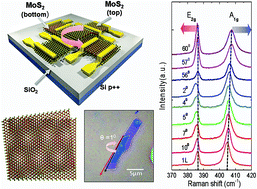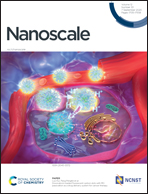Evolution of high-frequency Raman modes and their doping dependence in twisted bilayer MoS2†
Abstract
Twisted van der Waals heterostructures provide a new platform for studying strongly correlated quantum phases. The interlayer coupling in these heterostructures is sensitive to the twist angle (θ) and key to controllably tuning several interesting properties. Here, we demonstrate the systematic evolution of the interlayer coupling strength with twist angle in bilayer MoS2 using a combination of Raman spectroscopy and classical simulations. At zero doping, we observe a monotonic increase in the separation between the A1g and E2g1 mode frequencies as θ decreases from 10° → 1°, and the separation approaches that of a bilayer at small twist angles. Furthermore, using doping dependent Raman spectroscopy, we reveal the θ dependent softening and broadening of the A1g mode, whereas the E2g1 mode remains unaffected. Using first principles based simulations, we demonstrate large (weak) electron–phonon coupling for the A1g (E2g1) mode, which explains the experimentally observed trends. Our study provides a non-destructive way to characterize the twist angle and the interlayer coupling and establishes the manipulation of phonons in twisted bilayer MoS2 (twistnonics).



 Please wait while we load your content...
Please wait while we load your content...